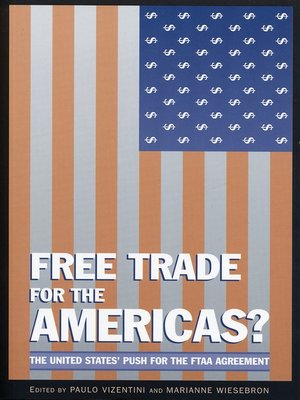Free Trade for the Americas?
ebook ∣ The United States' Push for the FTAA Agreement
By Marianne Wiesebron

Sign up to save your library
With an OverDrive account, you can save your favorite libraries for at-a-glance information about availability. Find out more about OverDrive accounts.
Find this title in Libby, the library reading app by OverDrive.



Search for a digital library with this title
Title found at these libraries:
| Library Name | Distance |
|---|---|
| Loading... |
The face of international trade is continuing to change rapidly. But while much attention is focused on where, post-Cancun, any new international negotiations under the auspices of the WTO may go, there are other developments of potentially equal importance. The United States, in particular, is prioritizing new regional trade agreements. This book focuses on the most ambitious of these negotiations — the Free Trade Area of the Americas Agreement, which is due to be completed in 2005.
This US initiative aims to replicate the NAFTA Agreement (which has bound the US, Canada and Mexico into a free trade area since 1994) across all 34 countries of South and North America (bar Cuba). This huge continental market is to be built around US-defined notions of free trade and protection of foreign investment, but will exclude the free movement of labour.
This volume explains the origins and process of the negotiations — both the complicated multilateral discussions and the bilateral agreements that have already been drafted. It explains in detail:
* US strategy.
* The structures and procedures of the Agreement.
* The possible consequences for South America, including: Mercosur; Brazil, as Latin America's largest economy; and the region's many small economies, which cannot possibly compete on a level playing field with the US behemoth.
* The wider implications of the FTAA for the global trading system, in particular for China, Japan and the EU.
This book — the first comprehensive, in-depth study of the FTAA — will be of use to trade specialists, international economists, and all those interested in the FTAA, about which very little information is readily available in the public domain.
This US initiative aims to replicate the NAFTA Agreement (which has bound the US, Canada and Mexico into a free trade area since 1994) across all 34 countries of South and North America (bar Cuba). This huge continental market is to be built around US-defined notions of free trade and protection of foreign investment, but will exclude the free movement of labour.
This volume explains the origins and process of the negotiations — both the complicated multilateral discussions and the bilateral agreements that have already been drafted. It explains in detail:
* US strategy.
* The structures and procedures of the Agreement.
* The possible consequences for South America, including: Mercosur; Brazil, as Latin America's largest economy; and the region's many small economies, which cannot possibly compete on a level playing field with the US behemoth.
* The wider implications of the FTAA for the global trading system, in particular for China, Japan and the EU.
This book — the first comprehensive, in-depth study of the FTAA — will be of use to trade specialists, international economists, and all those interested in the FTAA, about which very little information is readily available in the public domain.







